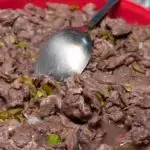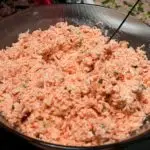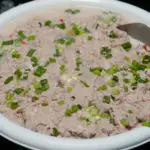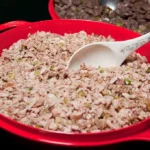Kelaguen: Meat, Chicken or Seafood with Lemon
Table of Contents
Share This
Description
Chopped chicken, meat, or seafood prepared with lemon juice.
History
Origin
Kelaguen is based on the “cooking” property of lemon juice, whereby raw fish or shrimp is “cooked” by the acidity of the lemon. This food preparation method is common to many Pacific islands people. It probably originated in Southeast Asia and was spread through migrations of people throughout the Pacific.
Evolution
The first people in the Marianas likely used the kelaguen method primarily with fish. In the early 1900s Georg Fritz, who served as the German District Officer of Saipan, described a CHamoru dish “fala” that is similar to the modern version of fish kelaguen.
The banana flower (fafalu), when chopped, soaked in saltwater and boiled, is also prepared as a kelaguen dish; and probably was used in ancient times. Other seafood, such as clams and shrimp, are prepared in this manner. As meats were introduced by the Spanish administration in the 17th century, the principle of “cooking” in lemon juice adapted to the properties of these new foods. Today, Spam has become an accepted kelaguen dish, especially as a beer chaser.
CHamorus are known for their kelaguen making skills. This dish is considered a signature local dish. Kelaguen’s popularity is evidenced when it is served as an appetizer or as part of the salad bar in several restaurants throughout the island whether or not they specialize in local food. At least one CHamoru family is known for preparing chicken kelaguen wrapped in taco-shell shaped titiyas (a Mexican tortilla) and selling them at local mom and pop stores and other establishments.
Preparation
Kelaguen uses a combination of lemon juice, salt, and hot peppers to “cook” some type of fish, shrimp or meat. The Spanish introduced hot pepper to the Marianas. CHamorus had the knowledge of how to make sea salt.
Grated fresh coconut meat is often added to the recipe, especially to chicken and fish kelaguen. Deer and beef are prepared raw, and “cooked” in lemon juice as well. Chicken, however, is barbecued (grilled over a charcoal or wood fire) or boiled, then chopped, and lemon juice and salt added. Octopus and squid can be boiled prior to chopping as well. Grated coconut is usually, but not always, added to chicken and seafood. Some chefs use lechen niyok (coconut cream) instead of grated coconut to prepare certain types of seafood kelaguen.
Placement on table
Kelaguen is placed on the table depending on the ingredients used. Chicken kelaguen is usually placed after the barbecued chicken and other meats. Seafood is usually grouped together, after the barbecued fish. In large parties it has become stylish to have a separate table with various kinds of seafood and kelaguen. (Kelaguen Spam is not considered a party food. It would remain in the back kitchen for beer drinkers to enjoy.)
Recipe
Kelaguen
The following recipe will instruct you on how to prepare kelaguen made of seafood, venison or beef or chicken.
- Choice of protein (shrimp, fish, chicken, etc.)
- Lemon juice
- Hot peppers
- Salt
- Onions, diced (Green onions may be used to garnish the dish)
- Coconut, grated (optional)
Chop the selected raw protein – seafood, venison, or beef. It is prudent to pour boiling water over the seafood to rinse any contaminants. Venison and beef should be squeezed under running hot water to remove some of the excess blood. If you want to prepare chicken kelaguen, debone and cook unseasoned chicken on a barbecue grill. Octopus should be boiled to firm up the tissue. Mix the chopped meat or seafood with enough lemon juice to penetrate the mixture, and keep mixing the raw protein until it looks “cooked”. Add salt and hot pepper to taste. Add onions and/or green onions. Add grated fresh coconut to chicken or shrimp in small amounts until a flavor balance is reached. Coconut should be only about ¼ volume compared to the protein. Either grated coconut or lechen niyok (coconut cream) may be added to fish. Octopus is usually prepared without coconut. Kelaguen tastes best after it has been refrigerated for a few hours to allow the flavors to blend.
* Recipe by Judy Flores, PhD
Video
Watch more Fiesta Table video demonstrations here.




